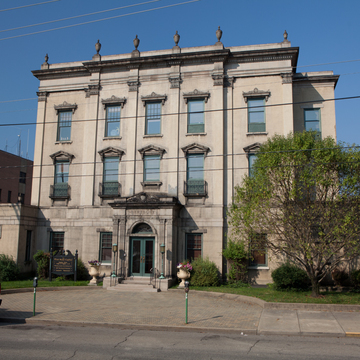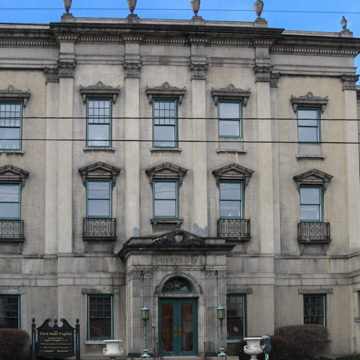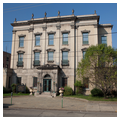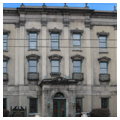You are here
Medical Arts Building (Linsly Institute)
Built as the Linsly Military Institute, this building was originally a gaunt, three-story brick academy with rudimentary Italianate details. Embryonic pilasters separated the bays, and brackets supported the cornice. When the institute moved to new quarters early in the twentieth century, Franzheim remodeled the building to serve an unlikely dual purpose: a mortuary on the main floor and apartments above.
Architecturally, the basic outlines were kept, but the applied details virtually transformed the building from a plain Jane to an Adamesque confection. The brick walls were stuccoed, terra-cotta and stone trim were added, pilasters received Corinthian capitals, and the bracketed cornice was transformed into a full entablature with urns above. Projecting one-story wings were added, and a new entry was appended. Whether intentional or not, what emerged is somewhat reminiscent of an English country house.
No matter its architectural changes, the building, which now serves as offices, has a lasting place in West Virginia history. After the thirty-fifth state was created on June 20, 1863, the legislature and governor began to hold meetings here rather than in Independence Hall. Consequently, the former Linsly Institute is considered West Virginia's first state capitol.
Writing Credits
If SAH Archipedia has been useful to you, please consider supporting it.
SAH Archipedia tells the story of the United States through its buildings, landscapes, and cities. This freely available resource empowers the public with authoritative knowledge that deepens their understanding and appreciation of the built environment. But the Society of Architectural Historians, which created SAH Archipedia with University of Virginia Press, needs your support to maintain the high-caliber research, writing, photography, cartography, editing, design, and programming that make SAH Archipedia a trusted online resource available to all who value the history of place, heritage tourism, and learning.




